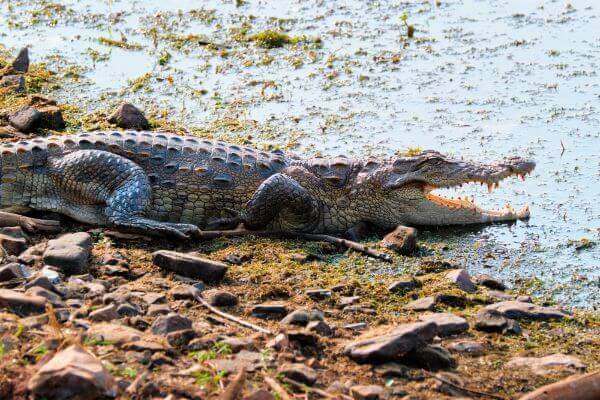Alligator and Crocodile Facts and Information
Crocodilians, those enigmatic lizard-shaped reptiles, traverse both freshwater and saltwater realms with their four short legs and long, muscular tails. Their hides, resembling a topographical map, boast rough scales that tell tales of their evolutionary journey. But within this scaly exterior lies a world of perplexity and burstiness, a realm where the subtle nuances of alligators and crocodiles dance in the intricacies of nature.
Distinguishing these ancient predators becomes an art form. Alligators, the shadowy figures of freshwater habitats, flaunt dark hues and a broad, rounded snout. On the other hand, crocodiles, the coastal daredevils, sport a grayish-green palette and a tapered, triangular snout. The devil, they say, is in the details—observe the fourth tooth on either side of the lower jaw. In alligators, it remains concealed, a hidden gem, while in crocodiles, it boldly asserts its presence even behind closed jaws.
Size becomes the canvas on which the tale of maturity unfolds. Male crocodilians, across species, don the crown of size superiority, standing as titans over their female counterparts. From the majestic saltwater crocodile, stretching over 6 meters, to the diminutive Cuvier’s dwarf caiman, barely reaching 1.6 meters, the crocodilian kingdom showcases a spectrum of sizes that adds to the enigma.
Feeding habits, another thread in the intricate tapestry of their existence, reveal a predatory prowess that spans the menu from fish to mammals. These creatures, with efficient four-chambered hearts akin to birds and mammals, defy the stereotype of reptilian simplicity. Their existence, a testament to resilience, hints at lifespans veiled in mystery—perhaps 50 to 60 years or more.
In the heartland of the United States, the American alligator and the American crocodile carve out their territories. The former, a resident of the southeastern states, and the latter is an endangered recluse in the southern tip of Florida. Their habitats, the tropical and subtropical havens of freshwater and saltwater, mirror the diversity of their existence.
As guardians of ecosystems, crocodilians emerge as essential players. Nile crocodiles, for instance, keep the balance in check by controlling the barbel catfish population. The domino effect unfolds—fish populations flourish, sustaining over 40 bird species. Nature’s intricate dance, where crocodiles play the role of both predator and scavenger, ensures the vitality of ecosystems.
But amidst the dance, the drumbeat of endangerment echoes. The International Union for Conservation of Nature (IUCN) lists 13 crocodilian species, with four teetering on the brink of extinction. CITES, the global watchdog, extends its guardianship over nearly all species, recognizing the fragility of their existence. In the United States, the American alligator treads the thin line of threatened status, while the American crocodile, with endangered hues, struggles for survival.
Journeying back through time, the fossils of Deinosuchus, the “terrible crocodile,” cast shadows of a bygone era. A skull, a fossil relic from Texas, speaks of a predator 15 meters long, challenging the very dinosaurs of its time. Crocodilians, survivors of epochs, wield vertical pupils that dilate in low light, transforming them into nocturnal hunters extraordinaire.
Alligators and crocodiles, the ancient sentinels, preserve the sanctity of their lineage with unchanging traits. Yet, within this steadfastness lies sophistication. Their hearts, efficient and four-chambered, echo the avian rhythm, setting them apart from their reptilian kin. A journey through the annals of ecology unveils their vital role—nature’s custodians, balancing the delicate web of life.
Distinguishing between these prehistoric behemoths, alligators, and crocodiles, becomes an art of observation. The snout is a telltale sign—broad and U-shaped in alligators, narrow and V-shaped in crocodiles. Teeth, the silent storytellers—hidden in alligators, exposed in crocodiles, each tooth narrating its saga. The color palette is a visual clue—dark for alligators, a subtle olive or tan for crocodiles. Habitat, the stage on which their drama unfolds—freshwater realms for alligators, saltwater frontiers for crocodiles.
Zooming in on their feet, the dichotomy deepens. Alligators, the webbed wonders, navigate aquatic landscapes with ease. Crocodiles, with separated toes and jagged fringes, bring a touch of the exotic to their terrestrial pursuits. The world of crocodilians is a paradoxical blend of ancient stoicism and dynamic adaptability.
Venturing beyond familiar territories, the realm of crocodilian diversity unfolds. American alligators, the giants of the Alligatoridae family, roam the Southern United States, their conservation battles etched in the landscapes of the Florida Everglades. Caimans, the lesser-known players, inhabit Central and South America, carving their stories in the swamps, lakes, and rivers. Chinese alligators, the critically endangered envoys, linger in the provinces of East China, a testament to the fragility of the species.
Within the tapestry of true crocodiles, the freshwater and saltwater players emerge. Nile crocodiles, the giants of sub-Saharan Africa, mirror the American crocodile in size and danger. Australian saltwater crocodiles, the colossal champions, claim the title of the largest crocodile species. The stage is set for a showdown—a classic, Godzilla-style faceoff. The verdict was a resounding victory for the crocodile, crowned by sheer size and power.
Yet, in the realm of danger to humans, a cautious dance unfolds. Alligators and crocodiles, instinctively wary of humans, tread the fine line between fear and desperation. Their lair, a realm of unpredictable danger, challenges the notion of lazy sun-bathers. Speed, a weapon concealed by their seemingly languid demeanor, unleashes its fury in a moment of provocation.
In the delicate ballet between man and reptile, caution emerges as the guiding principle. A safe distance, a respectful acknowledgment of their territories, becomes the key to coexistence. The “alligator vs. crocodile” saga, is a question best left to the realms of curiosity and documentaries, where the dangers remain within the frames of screens.
As the sun sets on the marshy landscapes they call home, alligators and crocodiles continue their timeless dance. The tale of these ancient predators, scripted in scales and teeth, unfolds in the vast canvas of nature. A canvas where perplexity and burstiness intertwine, painting a portrait of survival, adaptation, and the enigma of crocodilian existence.
